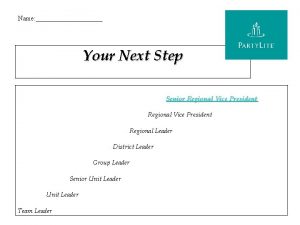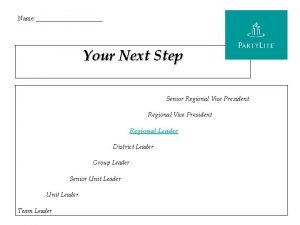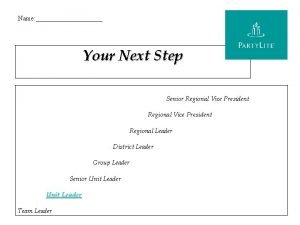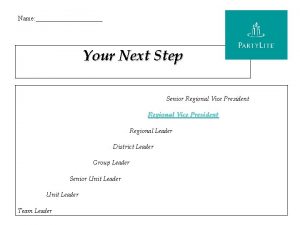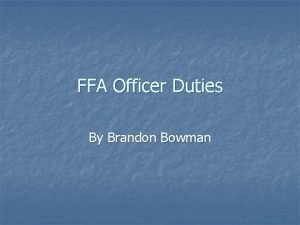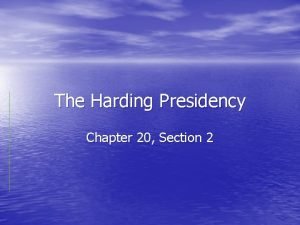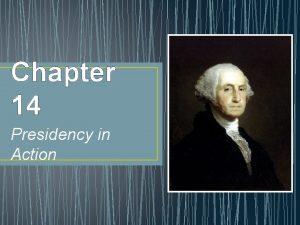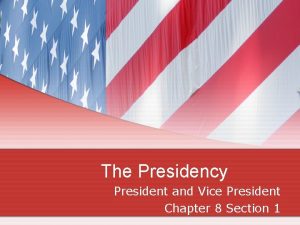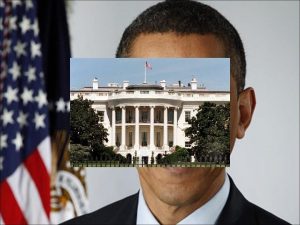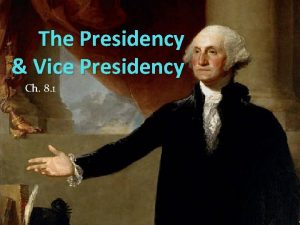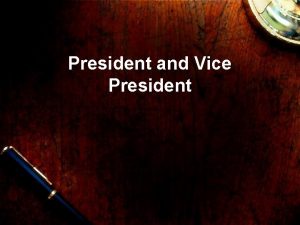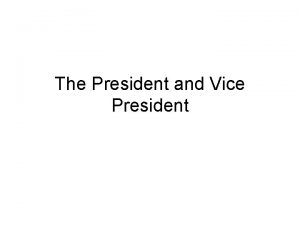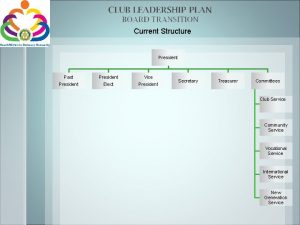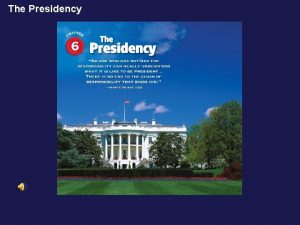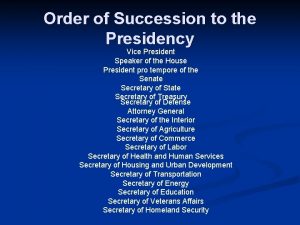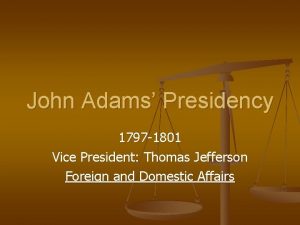The Presidency President and Vice President Chapter 8
















- Slides: 16

The Presidency President and Vice President Chapter 8 Section 1

Name: Date: January 5, 2010 Define 2 Terms (Pg. 213 or 219): 1) 2)

I. Duties of the President A. Commander in Chief Then: Washington – had a militia of 15, 000 volunteers Now: -Bush oversees all four major units of the military -Makes deployment decisions -Manages the defense budget of + $270 billion

B. Appointments With consent of the Senate, the President appoints: 1) Heads of Executive Departments 2) Federal Court Judges 3) Other Top Officials

C. Foreign Policy 1) Makes Treaties 2) Meets with other Heads of State 3) Hosts Foreign Officials 4) Appoints Ambassadors to represent the U. S. in other countries

D. Other Roles 1) Has the ability to pardon criminals 2) Shorten prison sentences (clemency) 3) Gives the State of the Union Address

II. President’s Term and Salary A. The Twenty-Second Amendment (1951) Franklin D. Roosevelt served for 4 terms in office. Many believed this gave too much executive power to one man. The Twenty-Second Amendment limits a President’s term to two terms (8 years).

B. Salary and Benefits Define: Compensation = Salary 1) Congress determines the President’s salary 2) In 1999, Congress raised the salary of the president to $400, 000 3) The President has a nontaxable travel allowance up to $100, 000 a year 4) Congress cannot increase or decrease the salary during a president’s term

II. Salary and Benefits (Con’t) 5) Free Medical, Dental, and Health Care 6) Gets to live in the White House - 132 room mansion Swimming pool Bowling alley Movie theater Tennis courts *Cooking, cleaning, and shopping are all taken care of by the White House domestic staff 7) Pension - $148, 400 a year

III. Presidential Qualifications A. Requirements for U. S. Presidents 1) Article II, Section 1 of the Constitution - Must be a natural-born U. S. citizen - Must be at least 35 years old - Must be a resident of the U. S. for at least 14 years (The requirements are the same for the Vice President)

B. Expectations 1. Political experience (Only five had no experience: Eisenhower) 2. Needs to have money or access to money to be elected 3. Should generally hold moderate positions on major issues

C. Characteristics for Most Presidents 1) Most Presidents have come from Northern European family backgrounds 2) Most have come from the Middle-Class; some from the Upper-Class 3) White, married, protestant, financially successful 4) Thus far, Presidents have only been male

IV. Presidential Succession Twenty-Fifth Amendment: The Vice President becomes President if the President is removed from office or dies The President nominates a Vice President if there is a vacancy (Congress has to approve with a majority)

Lines of Succession to Presidency 1) Vice President 2) Speaker of the House 3) The President pro tempore of the Senate 4) Secretary of State 5) Then the other 13 Department Heads in the order of when Congress created them (pg. 217)

V. Vice President’s Duties 1) Presides over Senate (votes when tie). 2) Acting President in case of disability or other circumstances 3) Do what the President assigns them to do

In-Class/Homework Questions Section 1 Assessment (Page 219) 1) 4) 5) Page 746 List Presidents #1 -15 and write 3 facts about each President do not use date of birth and death as facts.
 Ducks unlimited checks
Ducks unlimited checks Vice president duties in a club
Vice president duties in a club Mary jo fitzpatrick is the vice president
Mary jo fitzpatrick is the vice president Microsoft fargo campus
Microsoft fargo campus Age of vice president
Age of vice president Vice president training
Vice president training Senior regional vice president
Senior regional vice president Vice president membership
Vice president membership Where is the ffa vice president stationed
Where is the ffa vice president stationed Senior regional vice president
Senior regional vice president Senior regional vice president
Senior regional vice president Senior regional vice president
Senior regional vice president Ffa president duties
Ffa president duties Vice president quality
Vice president quality Vice president training
Vice president training Chapter 12 section 2 the harding presidency
Chapter 12 section 2 the harding presidency President appointment power
President appointment power






